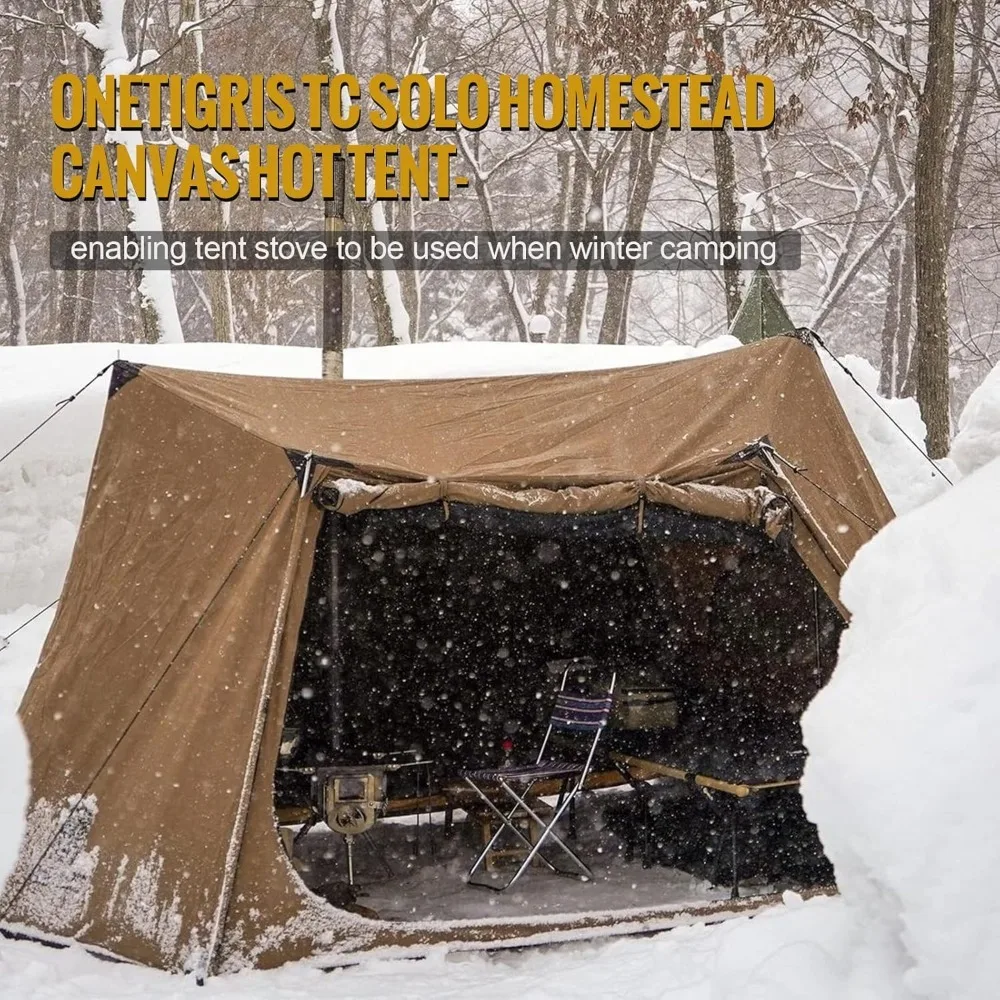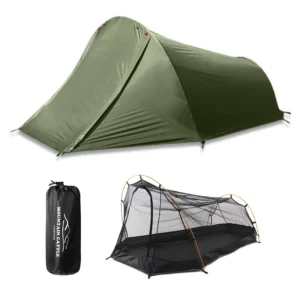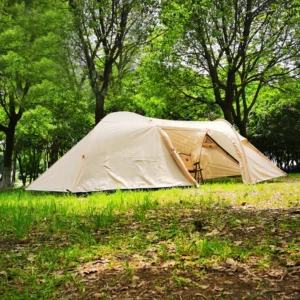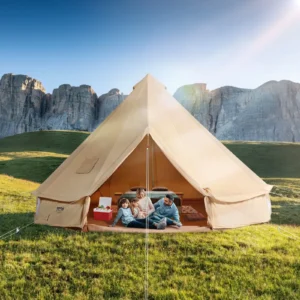Understanding the True Strength of Canvas in Harsh Elements
When venturing into the wilderness, your shelter becomes your lifeline against unpredictable elements. Canvas shelters have stood as reliable guardians for generations of outdoor enthusiasts, from early explorers to modern backcountry adventurers. But what exactly makes canvas such a trusted material for demanding conditions?
Canvas offers a unique combination of properties that synthetic materials struggle to match:
- Natural breathability that reduces condensation while maintaining warmth
- Superior insulation that regulates temperature in both hot and cold conditions
- Exceptional durability with resistance to tearing and puncturing
- Quieter performance in windy conditions compared to synthetic materials
The resilience of canvas in rough weather isn’t just folklore—it’s backed by centuries of practical use in military operations, wilderness expeditions, and sustained outdoor living. Understanding how canvas shelters perform in rugged camping environments can make the difference between a miserable experience and a comfortable adventure, regardless of what Mother Nature throws your way.
Quality canvas shelters differ significantly from budget alternatives in their material composition, treatment processes, and construction techniques. Throughout this guide, we’ll explore exactly how canvas performs against wind, rain, snow, UV exposure, and other challenging conditions—giving you the knowledge to select, set up, and maintain a shelter that truly stands up to the elements.
Canvas Material Analysis: The Science Behind Weather Resistance
Not all canvas is created equal. The material’s performance in harsh weather conditions depends significantly on its composition, weight, and treatments. Understanding these differences helps you make informed decisions when selecting a shelter for challenging environments.
Canvas Types and Their Weather-Resistant Properties
Traditional Cotton Canvas (Duck Canvas) is made from 100% cotton fibers in a tight, plain weave. It offers excellent breathability and a comfortable interior environment but requires proper treatment to achieve water resistance. When wet, cotton fibers swell, creating a naturally tighter weave that enhances water resistance once properly “weathered.”
Polycotton Canvas blends cotton with polyester (typically 35-50% polyester) to enhance durability while maintaining breathability. This hybrid material offers improved resistance to mildew and rot compared to pure cotton canvas, with faster drying times and reduced weight—making it increasingly popular for modern canvas shelters.
Acrylic Canvas represents the premium end of the spectrum with outstanding UV resistance, colorfastness, and water-repelling capabilities. While more expensive, acrylic canvas maintains its protective properties significantly longer, making it ideal for shelters intended for extended exposure or permanent setups.
The definitive guide to heavy-duty canvas shelters explains that fabric weight, measured in ounces per square yard (oz/yd²) or grams per square meter (g/m²), directly correlates with durability and weather protection. Premium canvas shelters typically use:
- Light-duty: 8-10 oz/yd² (270-340 g/m²)
- Medium-duty: 10-12 oz/yd² (340-407 g/m²)
- Heavy-duty: 13-16+ oz/yd² (440-542+ g/m²)
Crucial Treatments That Enhance Performance
Water resistance in canvas comes from specialized treatments including:
| Treatment Type | Benefits | Durability |
|---|---|---|
| Paraffin/Wax | Traditional, excellent water resistance | Requires periodic reapplication |
| Silicone | Good water repellency, flexible | Moderate longevity |
| Fluoropolymer | Superior water & stain resistance | Longest-lasting option |
| Acrylic | Excellent UV & water protection | Very good longevity |
Additionally, quality canvas shelters incorporate:
* Mildew/rot resistance treatments that prevent organic breakdown in humid conditions
* UV inhibitors that slow degradation from sun exposure
* Fire retardant applications for safety around campfires and stoves
The tight weave pattern of premium canvas creates minute spaces small enough to block water droplets while still allowing water vapor to escape—the perfect balance between protection and comfort that makes most durable tent materials so effective in varying conditions.
Structural Elements: What Makes or Breaks a Canvas Shelter
While the canvas material itself provides the weather barrier, the structural framework determines how the shelter performs under stress. Even the finest canvas will fail if its supporting structure cannot withstand environmental pressures.
Frame Materials and Their Impact
Steel frameworks offer unparalleled strength and stability, making them ideal for shelters designed to withstand extreme conditions. Their weight-to-strength ratio makes steel the preferred choice for:
* Base camp setups
* Extended-stay shelters
* Locations with potential for severe weather
* Areas with significant snow load concerns
Aluminum systems provide a lighter alternative while maintaining good strength. These frames excel in:
* Situations requiring more frequent relocation
* Moderately challenging weather conditions
* Reducing overall pack weight
* Environments where corrosion resistance is crucial
Hybrid designs incorporate strategic use of both materials, often using steel for critical load-bearing elements while reducing weight elsewhere with aluminum components.
Critical Reinforcement Points
The durability of canvas shelters in rough weather depends heavily on reinforcement at key stress points:
- Double-stitched seams with marine-grade thread prevent separation under tension
- Heavy-duty zippers with protective flaps prevent water intrusion at openings
- Reinforced corners with multiple layers of fabric distribute strain
- Strategic guy line placement allows proper tension distribution in high winds
- Robust stake points that won’t tear out during sudden gusts
A thorough understanding of tent material durability factors reveals that the integration of these structural elements with quality canvas creates a synergy that exceeds the performance of either component alone.
The most weather-resistant canvas shelters feature frame designs like the center-pole system (excellent for snow load distribution), A-frame construction (superior stability in winds), or the Flex-Bow design that combines rigidity with enough flexibility to absorb wind gusts rather than fighting against them.
Wind Resistance: How Canvas Shelters Stand Against Gales
When fierce winds blow, the weight and natural properties of canvas provide distinct advantages over lightweight synthetic materials. Quality canvas is less prone to the constant flapping that plagues nylon and polyester tents, resulting in a quieter, more stable shelter during windy conditions.
Premium canvas shelters are typically rated to withstand sustained winds of 30-40 mph (48-64 kph) and gusts up to 50-60 mph (80-97 kph) when properly secured. The heaviest expedition-grade canvas structures can perform reliably in even stronger conditions with appropriate setup.
Canvas performance in high winds depends on several factors:
- Aerodynamic profile – Lower, dome-shaped designs deflect wind more effectively than tall, vertical walls
- Proper tensioning – Canvas must be taut to prevent wind catch and material fatigue
- Strategic orientation – Positioning narrower ends toward prevailing winds reduces surface area exposure
- Adequate anchoring – Using all provided guy lines and stakes is essential, not optional
Mastering wind stability in freestanding tents becomes particularly important with canvas shelters due to their typically larger surface area. Techniques like using additional guy lines, employing heavy-duty stakes, and securing guy lines to rocks or trees in extremely high winds can dramatically improve performance.
Remember that canvas’s weight—often considered a disadvantage for transport—becomes a significant advantage in windy conditions by providing greater stability and resistance to movement once set up.
Water Resistance: Staying Dry Through Downpours
Canvas shelters have a somewhat complex relationship with water. While not inherently waterproof like synthetic materials with laminated coatings, properly treated and weathered canvas provides excellent water resistance that can keep occupants dry through extended downpours.
The Critical “Weathering” Process
New canvas shelters require an initial weathering process to achieve optimal water resistance. When canvas first gets wet, the cotton fibers swell and tighten the weave. This natural process, combined with proper tensioning, helps seal tiny gaps:
- Set up your new tent before your first trip
- Thoroughly soak it with water (garden hose works well)
- Allow it to dry completely while maintaining proper tensioning
- Repeat once more for optimal results
This process, combined with factory treatments, creates a highly water-resistant barrier that will keep you dry in all but the most extreme conditions.
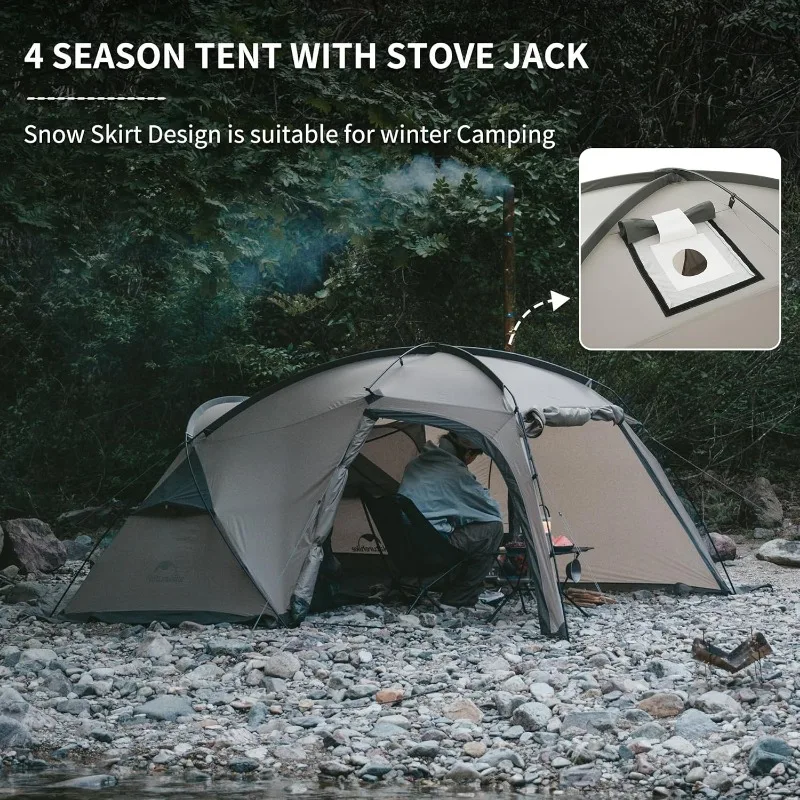
Pro Tip: Never pack or store a canvas shelter while damp. This prevents mildew growth and preserves water-resistant treatments.
The tight weave and treatments cause water to bead on the surface rather than penetrate—a property that can be maintained through proper care and occasional retreatment. Understanding the benefits of waterproofing outdoor gear helps extend your shelter’s performance in wet conditions.
Canvas’s breathability provides another significant advantage during rainy weather: reduced condensation. While impermeable synthetic tents often develop interior moisture from trapped breath and body vapor, canvas allows this moisture to escape while still repelling external water—keeping sleeping areas noticeably drier.
Snow and Cold Weather Performance: Winter-Ready Canvas
Canvas shelters excel in winter conditions, offering several advantages over synthetic alternatives when facing snow and cold.
Structural Considerations for Snow
Quality canvas shelters withstand snow loads through:
- Steeper roof angles that shed snow rather than collecting it
- Stronger frames designed to support additional weight
- Strategic reinforcement at peak stress points
- Higher-denier canvas that resists stretching under load
For safety and structure longevity, it’s important to periodically brush accumulated snow from your shelter—particularly when wet, heavy snow is falling. Most quality canvas shelters can handle several inches of light snow between clearings.
Insulation Properties
Canvas provides natural insulation superior to synthetic tent materials:
- Maintains warmer interior temperatures through thermal mass
- Creates a more stable interior environment with fewer temperature fluctuations
- Reduces the chilling effect of wind
- Compatible with internal heat sources when properly equipped
Insulated canvas shelters for cold weather camping often incorporate additional features like stove jacks for wood stoves, which are rarely found in synthetic tents due to fire concerns. This compatibility makes canvas an excellent choice for comfortable winter camping.
When selecting a canvas shelter for winter use, consider winter camping tents designed specifically for cold conditions, with features like snow skirts, reinforced poles, and appropriate ventilation to prevent condensation freeze.
UV Exposure and Environmental Factors: Long-Term Durability
While canvas offers impressive resilience against various weather conditions, prolonged exposure to ultraviolet radiation presents challenges for any outdoor material. Canvas generally outperforms many synthetic materials in UV resistance, but performance varies significantly between canvas types.
UV Resistance Comparison
- Traditional cotton canvas shows moderate UV resistance but will gradually weaken with extended exposure
- Polycotton blends offer improved UV resistance due to the synthetic component
- Acrylic canvas provides superior UV protection, maintaining strength and color for years of continuous exposure
UV degradation typically manifests as:
* Fabric becoming brittle and prone to tearing
* Visible fading or yellowing
* Reduced water resistance
* Weakening of stress points and seams
For shelters used in high-altitude, desert, or tropical environments where UV exposure is intense, selecting canvas with additional UV inhibitors or acrylic composition becomes particularly important.
Mold and Mildew Management
Canvas’s organic composition makes it vulnerable to mold and mildew, which can compromise both appearance and structural integrity. Prevention is far easier than treatment:
- Ensure complete drying before storage
- Store in dry, well-ventilated areas
- Use anti-mildew treatments as directed in the canvas tent care guide
- Address any signs of mildew immediately with appropriate cleaners
Regular inspection and maintenance significantly extend the life of canvas shelters, allowing them to provide reliable protection through many seasons of challenging conditions.
Setup and Site Selection: Maximizing Weather Protection
The inherent weather resistance of canvas can be either enhanced or compromised by setup technique and site selection. Even the finest canvas shelter will underperform if poorly positioned or improperly secured.
Strategic Site Selection
Before unpacking your shelter, evaluate potential campsites for:
- Natural windbreaks such as rock formations, dense shrubs, or terrain features
- Proper drainage to prevent water pooling beneath or around your shelter
- Even ground free from sharp objects that could damage flooring
- Overhead hazards including dead branches or loose rocks
- Sun exposure considerations for temperature management
- Soil composition that allows secure staking
Weather-Optimized Setup
Following canvas tent setup guide expert tips significantly improves performance in challenging conditions:
- Orient for weather protection – Position the narrowest profile toward prevailing winds
- Achieve proper tensioning – Canvas should be taut but not overstretched
- Use all attachment points – Every stake point and guy line serves a purpose
- Stake correctly – Drive stakes at 45° angles away from the tent for maximum holding power
- Consider additional anchoring for extreme conditions – Rocks on corners, extra guy lines to trees, or heavy-duty stakes
Proper setup creates a stable, weather-resistant shelter that fully utilizes the natural strengths of canvas construction.
Canvas vs. Synthetic Shelters: The Ultimate Durability Comparison
When evaluating shelter options for rough weather conditions, understanding the comparative strengths and limitations of different materials becomes crucial. This comparison helps align your selection with specific environmental challenges and personal priorities.
| Performance Factor | Canvas | Synthetic (Nylon/Polyester) |
|---|---|---|
| Wind stability | Excellent – weight provides stability, minimal flapping | Good to Fair – lighter weight causes more movement |
| Water resistance | Very Good (when properly treated) – naturally tightens when wet | Excellent – completely waterproof with sealed seams |
| Snow load capacity | Excellent – stronger materials handle weight well | Fair to Good – depends heavily on pole structure |
| UV durability | Good to Excellent – especially treated canvas | Fair – degrades faster under constant sun exposure |
| Breathability | Excellent – reduces condensation | Poor to Fair – often requires additional ventilation |
| Temperature regulation | Excellent – warmer in cold, cooler in heat | Fair – transfers external temperatures more readily |
| Noise in wind | Very Good – minimal flapping | Poor to Fair – often noisy in moderate winds |
| Weight | Heavy – less portable | Excellent – lightweight and compact |
| Lifespan (with proper care) | 10-20+ years | 3-7 years |
| Maintenance requirements | Moderate – regular care needed | Low – less maintenance required |
The comparison between canvas vs. nylon tents for wilderness use highlights that canvas excels in long-term durability, comfort, and extreme weather resilience, while synthetic materials offer significant advantages in weight, packability, and immediate setup simplicity.
For base camps, extended stays, or locations with particularly challenging weather, canvas shelters typically justify their additional weight and setup complexity through superior durability and comfort. Browse our selection of canvas camping tents to explore options designed for durability in harsh conditions.
Key Features to Look for in Weather-Resistant Canvas Shelters
When selecting a canvas shelter for rough weather conditions, certain features distinguish truly durable options from those that will disappoint when conditions deteriorate.
Essential Canvas Quality Indicators
- Fabric weight – Look for 10-16 oz/yd² (340-542 g/m²) depending on intended use
- Material composition – 100% cotton for traditional performance or polycotton blends for reduced weight and faster drying
- Treatment specifications – Water-repellent, UV-resistant, and mildew-resistant treatments
- Weave tightness – Tighter weaves provide better weather protection
Critical Construction Features
- Double-stitched seams with reinforcement at stress points
- Marine-grade thread that resists degradation from moisture and UV
- Heavy-duty YKK zippers with protective storm flaps
- Reinforced corners and attachment points
- Multiple guy line attachment points for customized stabilization
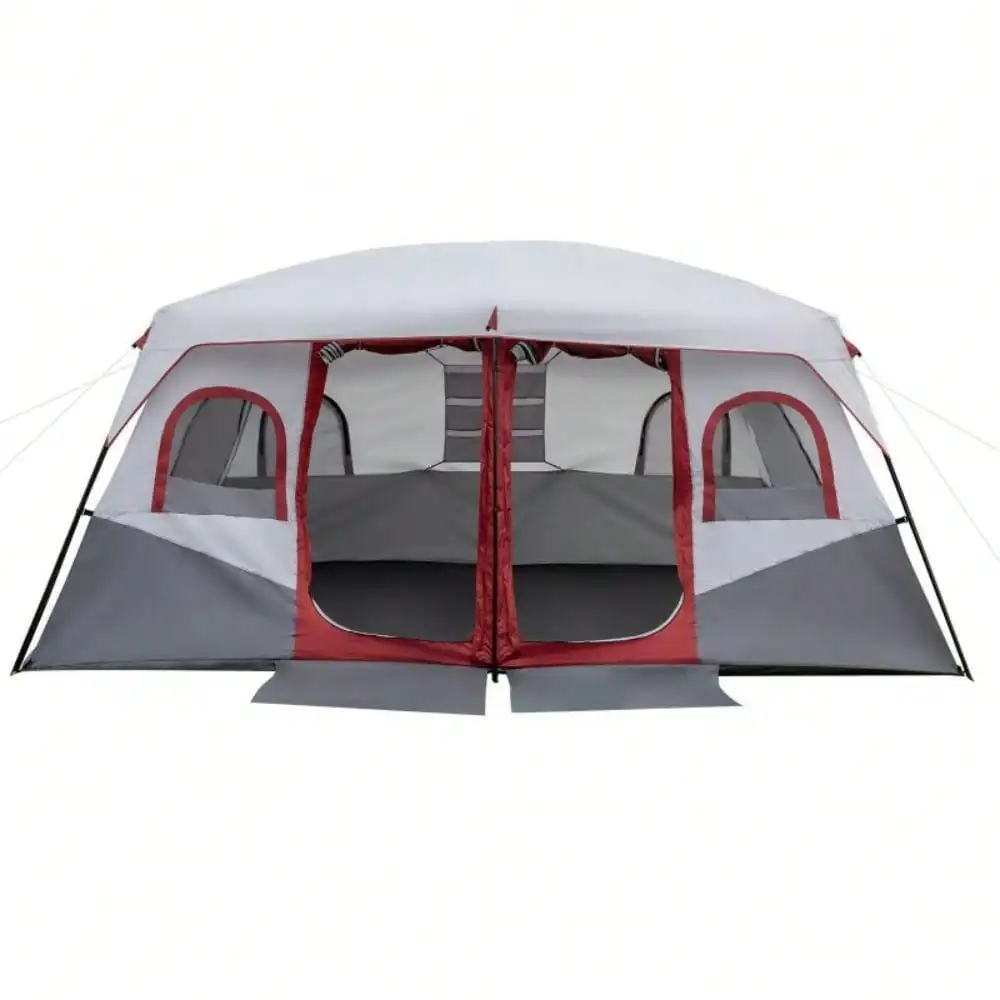
Frame Considerations
- Material strength – Steel offers maximum stability for extreme conditions
- Pole diameter – Larger diameters provide greater strength against bending
- Connection mechanisms – Socket joints typically offer more stability than slip-together designs
- Flexibility balance – Frames should have enough give to absorb wind gusts without breaking
For those seeking shelters designed specifically for challenging conditions, explore our selection of heavy-duty 4-season tents that incorporate these critical features for maximum durability.
Is Canvas Right for Your Extreme Weather Needs?
Different environmental challenges call for specific shelter characteristics. Consider these scenario-based assessments to determine if canvas aligns with your particular situation:
Q: I frequently camp in coastal areas with unpredictable, strong winds. Is canvas suitable?
A: Canvas excels in windy environments due to its weight and stability. When properly secured with all guy lines, canvas shelters experience less flapping and movement than synthetic alternatives. Choose models with aerodynamic profiles and reinforced pole structures for optimal performance.
Q: I’m planning extended trips in regions with heavy rainfall. Can canvas keep me dry?
A: Properly treated and weathered canvas provides excellent protection in rainy conditions. For prolonged exposure, select shelters with steeper roof angles to promote water runoff and prevent pooling. Remember that new canvas shelters require proper weathering before achieving optimal water resistance.
Q: How does canvas perform for winter camping with significant snowfall?
A: Canvas is an excellent choice for snow conditions when selecting appropriate designs. Look for steep roof angles, strong frame systems, and reinforced stress points. Canvas also offers superior insulation and compatibility with safe heating options, making it preferred for comfortable winter camping.
Q: I’m heading to the desert with intense sun exposure. Will canvas hold up?
A: Canvas with proper UV treatments outperforms many synthetic materials in desert conditions. The natural breathability keeps interiors cooler during hot days, while providing insulation during cold desert nights. For extended desert use, acrylic canvas or heavily treated cotton canvas offers the best UV resistance.
Our waterproof camping tent collection includes options designed for these specific environmental challenges.
Essential Maintenance for Long-Term Canvas Durability
With proper care, canvas shelters can provide decades of reliable service—far outlasting synthetic alternatives. This longevity, however, depends on consistent maintenance practices.
Cleaning Protocols
Different soiling requires specific approaches:
- General dirt and dust – Brush with a soft brush when dry, then clean with mild soap and warm water
- Tree sap or stubborn stains – Spot clean with specialized canvas cleaners
- Mildew spots – Treat immediately with a solution of 1 part white vinegar to 4 parts water, scrubbing gently
Critical Drying and Storage Practices
- Never pack or store canvas when damp or wet
- Set up completely for drying after exposure to moisture
- Ensure air circulation reaches all surfaces, including under flooring
- Store in dry, well-ventilated areas in loose folds rather than tight bundles
- Use breathable storage bags rather than airtight containers
Waterproofing Maintenance
Canvas shelters typically need retreatment every 1-3 seasons depending on use frequency and conditions:
- Clean thoroughly and allow to dry completely
- Apply appropriate canvas-specific waterproofing treatment
- Pay special attention to seams and high-wear areas
- Allow to dry completely before storage
Four-season tents built for durability require consistent maintenance to preserve their weather-resistant properties. Regular inspections help identify small issues before they become significant problems—a stitch in time truly saves nine when it comes to canvas repair.
When Does Canvas Fail? Understanding Limitations and Solutions
Even the finest canvas shelters have limitations. Understanding potential failure points helps you prevent problems and respond effectively when issues arise.
Common Failure Points and Solutions
Seam Leakage in Extended Rain
* Prevention: Apply seam sealer during regular maintenance
* Solution: Temporary field fix with wax or emergency seam sealer; proper seam sealing after drying
Frame Stress in High Winds
* Prevention: Use all guy lines, orient shelter correctly, choose protected sites
* Solution: Reinforce with additional guy lines, lower profile if possible, create windbreaks
UV Degradation on Extended Exposure
* Prevention: Choose UV-treated canvas, minimize unnecessary sun exposure
* Solution: Apply UV protectant treatments, repair weakened areas promptly
Mold/Mildew Growth
* Prevention: Ensure complete drying before storage, store in ventilated conditions
* Solution: Clean with appropriate mildew cleaner, dry thoroughly, apply preventive treatment

Heavy Duty 4 Season Tent, Mountaineering Tent, Winter Camping Tent
$870.40 Select options This product has multiple variants. The options may be chosen on the product pageCompact Backpacking Tent, Lightweight Backpacking Tent, Waterproof Camping Tent
$335.52 Select options This product has multiple variants. The options may be chosen on the product pageUltralight Backpacking Tent, Ultralight Dome Tent, Winter Camping Tent
Price range: $369.63 through $370.07 Select options This product has multiple variants. The options may be chosen on the product pageCamping Tent with Vestibule, Waterproof Camping Tent
Price range: $407.89 through $479.48 Select options This product has multiple variants. The options may be chosen on the product pageHeavy Duty 4 Season Tent, Ultralight Freestanding Tent, Winter Camping Tent
$3,722.66 Select options This product has multiple variants. The options may be chosen on the product page- $1,221.93 Select options This product has multiple variants. The options may be chosen on the product page
Canvas shelters typically show warning signs before catastrophic failure. Watch for:
* Thinning fabric or visible light through previously opaque areas
* Stretching or deformation that doesn’t recover when dry
* Seams that begin to separate or pucker
* Increasing water penetration despite retreatment
For extreme conditions, consider our 4-season winter 2-person tents designed specifically to handle challenging environments.
The Long-Term Value Perspective: Why Canvas Endures
In an era of disposable goods, canvas shelters stand as a testament to the value of investing in quality materials built for longevity. While the initial investment typically exceeds that of synthetic alternatives, the extended usable life offers superior value over time.
Beyond simple economics, canvas shelters provide a level of comfort, stability, and reliability in rough weather that creates peace of mind during outdoor adventures. The natural breathability creates a more pleasant interior environment, while the substantial construction offers confidence when winds rise and storms approach.
From an environmental perspective, the longevity of quality canvas shelters reduces waste compared to repeatedly replacing synthetic tents every few years. This durability represents responsible consumption—choosing quality items intended to last rather than frequently replacing inferior alternatives.
For those who regularly venture into environments where shelter reliability directly impacts safety, the proven performance of mountaineering tents with canvas construction offers assurance that cannot be quantified merely in dollars.
Must-Know Canvas Shelter FAQ: Expert Answers
Q: How long can a well-maintained canvas shelter last?
A: With proper care and maintenance, premium canvas shelters can remain serviceable for 10-20+ years, even with regular use. This significantly exceeds the 3-7 year average lifespan of synthetic tents.
Q: Can canvas tents withstand continuous exposure to elements?
A: While canvas is more durable than synthetic materials for extended setup, continuous exposure will eventually degrade any fabric. For seasonal use (3-6 months), properly treated canvas performs exceptionally well. For permanent setups, acrylic canvas offers the best longevity.
Q: What’s the best repair method for tears or punctures?
A: Small tears can be repaired with canvas repair tape as a temporary field fix. For permanent repairs, hand-sewing with waxed thread followed by seam sealer application provides the strongest, most weather-resistant solution.
Q: How do I know when my canvas needs re-waterproofing?
A: Re-waterproofing is needed when you notice water no longer beading on the surface or when slight dampness appears inside during rainfall. For most users, retreating every 12-24 months of active use maintains optimal water resistance.
Q: Can canvas shelters truly handle four-season use?
A: Yes, quality canvas shelters often outperform synthetic alternatives in four-season use. Their superior insulation, compatibility with safe heating options, and structural strength make them excellent for winter camping when properly designed and maintained.

